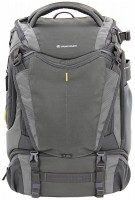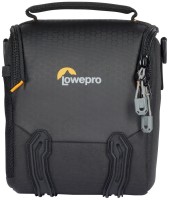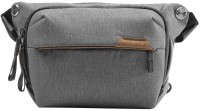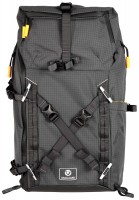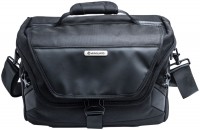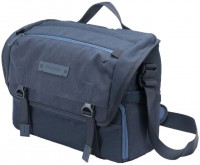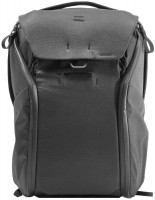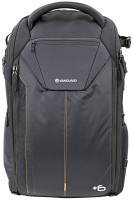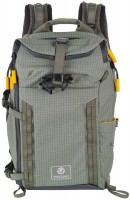Camera Bags Think Tank
All Camera Bags Advanced filters → |
You might be interested in
Camera Bags: specifications, types
Features
— For cameras (SLR). Bags or other protective gear designed for SLR cameras. These cameras are much larger in size than most compacts; in addition, when using them, you have to deal with a lot of removable accessories — lenses, flashes, boosters, etc. With this in mind, products for this purpose should have good capacity, and ideally also compartments or external pockets for additional equipment. On the other hand, there is no official division into bags for SLRs...and compacts, so in this case it is rather arbitrary. In our catalog, models for SLR cameras include two types of products: first, those in which the size of at least one of the dimensions is 150 mm or more; secondly, those in which special equipment is provided, such as a separate pocket for the lens (regardless of the dimensions of the bag).
— For cameras (compacts). Bags designed for use with compact cameras. In addition to their small size, such cameras are also characterized by battery life — in the sense that everything necessary for shooting is usually built into the device itself: non-removable optics, its own flash, etc. Therefore, bags for compact equipment do not need large sizes and additional pockets / compartments. Therefore, in our catalog, compact models include all products whose dimensions do not exceed 150 mm, and the design does not provide special “mirror” equipment (for more details on such equipment, see above).
— For video cameras. A bag for a video camera, designed to protect against mechanical damage and accidental shock. They can be additionally protected by a frame made of plastic or metal, which gives additional rigidity. A variety of materials are used for manufacturing. Equipped with additional inner or outer pockets.
— For lenses. The bag is designed to protect interchangeable lenses of photo and video devices.
— Case for tripods. Cases are available in different sizes (length) to fit a variety of tripod heads. The wardrobe trunk, usually, opens with a full-length zipper, which allows you to quickly put in or take out a tripod. Often, moisture-proof materials are used for manufacturing.
— For cameras (compacts). Bags designed for use with compact cameras. In addition to their small size, such cameras are also characterized by battery life — in the sense that everything necessary for shooting is usually built into the device itself: non-removable optics, its own flash, etc. Therefore, bags for compact equipment do not need large sizes and additional pockets / compartments. Therefore, in our catalog, compact models include all products whose dimensions do not exceed 150 mm, and the design does not provide special “mirror” equipment (for more details on such equipment, see above).
— For video cameras. A bag for a video camera, designed to protect against mechanical damage and accidental shock. They can be additionally protected by a frame made of plastic or metal, which gives additional rigidity. A variety of materials are used for manufacturing. Equipped with additional inner or outer pockets.
— For lenses. The bag is designed to protect interchangeable lenses of photo and video devices.
— Case for tripods. Cases are available in different sizes (length) to fit a variety of tripod heads. The wardrobe trunk, usually, opens with a full-length zipper, which allows you to quickly put in or take out a tripod. Often, moisture-proof materials are used for manufacturing.
Product type
— Case. Provides minimal protection - mainly from dust, scratches and (sometimes) moisture. Well suited, for example, to be carried by hand or in a larger bag along with other things. The advantage of covers is compactness and small weight.
- Case. Made in the form of a pencil case. In the middle there are different departments, both for the camera itself and for various accessories, such as additional memory cards, a...battery, a cloth for cleaning the camera or its optics. It is made from fairly rigid materials.
- Bag. Classic bags are very versatile, well suited for any travel, usually have additional internal and external compartments. The thick and soft materials that most bags are made of provide some degree of shock protection even in the officially ''non-shock proof'' models. As a rule, they are equipped with a carrying handle and a shoulder strap.
— Backpack. Dedicated backpack with camera compartment. As a rule, they are made of waterproof materials. They are very convenient when transporting, as they allow carrying on the shoulders. Sufficiently capacious, in addition to photo and video equipment, they are designed for a variety of additional things.
— Case. They have the highest degree of protection compared to other types of camera bags. As a rule, they are made of metal, aluminum is most often used; when using textile or leather materials, a stiffening frame (plastic, metal) is added to the structure. The case can easily accommodate photo-video equipment and a set of lenses for it.
- Suitcase. Models of various shapes and types, which are equipped with wheels. As a rule, they are designed to carry not only photo and video cameras and accessories, but also a fairly large number of additional things. This option is useful for tech who have to travel frequently.
- Case. Made in the form of a pencil case. In the middle there are different departments, both for the camera itself and for various accessories, such as additional memory cards, a...battery, a cloth for cleaning the camera or its optics. It is made from fairly rigid materials.
- Bag. Classic bags are very versatile, well suited for any travel, usually have additional internal and external compartments. The thick and soft materials that most bags are made of provide some degree of shock protection even in the officially ''non-shock proof'' models. As a rule, they are equipped with a carrying handle and a shoulder strap.
— Backpack. Dedicated backpack with camera compartment. As a rule, they are made of waterproof materials. They are very convenient when transporting, as they allow carrying on the shoulders. Sufficiently capacious, in addition to photo and video equipment, they are designed for a variety of additional things.
— Case. They have the highest degree of protection compared to other types of camera bags. As a rule, they are made of metal, aluminum is most often used; when using textile or leather materials, a stiffening frame (plastic, metal) is added to the structure. The case can easily accommodate photo-video equipment and a set of lenses for it.
- Suitcase. Models of various shapes and types, which are equipped with wheels. As a rule, they are designed to carry not only photo and video cameras and accessories, but also a fairly large number of additional things. This option is useful for tech who have to travel frequently.
Capacity
The total volume of the bag, as a rule, includes all regular pockets (including external ones). However, manufacturers can indicate the volume of only the main compartment. A large volume allows you to put a lot of things inside the camera, but it significantly affects the dimensions, weight and price of the product itself. Therefore, when choosing, you need to strike a balance between capacity and convenience.
Compartments for photographic equipment
When choosing a camera bag, pay attention to the size of the camera compartment. This compartment is designed for storage and safe transportation of photographic equipment, and has dense and soft protective walls. The larger the size of the camera and the number of lenses / photo accessories used, the larger and more spacious the compartment for storing them should be.
Removable partitions
In semi-professional and professional models, the camera / lens compartment is equipped with removable soft partitions. This allows you to adjust the interior space of the compartment to your liking.
Increase in internal capacity
The possibility of increasing the internal volume of the bag at the request of the user. Most often, it is implemented due to a special zipper, when unzipped, the bag “unfolds”, increasing in size and, accordingly, in volume. This feature is useful primarily for those who have to deal with several cameras of different sizes. For example, for a compact amateur camera, a folded bag will be enough, which will not take up extra space, but for an advanced camera with a set of optics, the bag can be e...xpanded and everything will fit.

